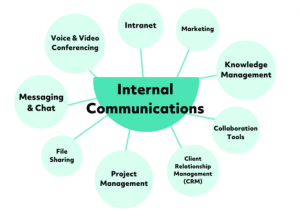The use of technology in internal communication within organizations has transformed the way teams collaborate, share information, and stay connected. Technological tools have streamlined communication processes, enhanced efficiency, and fostered a more connected and engaged workforce. Here are various ways technology is utilized for internal communication:

Use of Technology in Internal Communication within Organizations
Table of Contents
Toggle1. Collaboration Platforms:
- Examples: Microsoft Teams, Slack, and Asana.
- Functionality: These platforms facilitate real-time communication, document sharing, and project collaboration. Teams can have discussions, share files, and coordinate tasks in a centralized space.
2. Intranet Systems:
- Examples: SharePoint, Jive, and Confluence.
- Functionality: Intranet systems serve as a centralized hub for internal communication. They host company announcements, policies, documents, and other resources, providing a single source of truth for employees.
3. Email and Messaging Apps:
- Examples: Outlook, Gmail, and business messaging apps.
- Functionality: Email remains a primary tool for formal communication, while messaging apps allow for quick and informal communication. Both are essential for keeping teams informed and connected.
4. Video Conferencing:
- Examples: Zoom, Microsoft Teams, and Google Meet.
- Functionality: Video conferencing tools facilitate virtual meetings, enabling face-to-face communication for remote or dispersed teams. They enhance collaboration and foster a sense of connection among team members.
5. Employee Social Networks:
- Examples: Workplace by Facebook, Yammer, and Slack channels.
- Functionality: Internal social networks provide a platform for employees to connect, share updates, and engage in discussions. They contribute to a sense of community within the organization.
6. Mobile Apps:
- Examples: Employee engagement apps, mobile intranet apps.
- Functionality: Mobile apps enable employees to access internal communication tools on the go. This is crucial for remote workers or those who need to stay connected while away from their desks.
7. Digital Newsletters:
- Examples: Custom email newsletters, platforms like Mailchimp.
- Functionality: Digital newsletters deliver updates, news, and important information directly to employees’ inboxes, ensuring that they stay informed about organizational developments.
8. Podcasts and Webcasts:
- Examples: Internal podcasts, live streaming platforms.
- Functionality: Podcasts and webcasts provide a dynamic and engaging way to share information. They are effective for conveying messages from leadership, discussing company updates, and conducting training sessions.
9. Survey and Feedback Tools:
- Examples: SurveyMonkey, Google Forms, and employee feedback platforms.
- Functionality: These tools allow organizations to gather feedback from employees, measure satisfaction, and assess the effectiveness of internal communication strategies.
10. Digital Signage:
- Examples: Screens in common areas, digital bulletin boards.
- Functionality: Digital signage is used to display announcements, key performance indicators, and other relevant information in common areas, ensuring that important messages reach all employees.
11. AI-Powered Chatbots:
- Examples: Chatbots integrated into communication platforms.
- Functionality: AI-powered chatbots can provide instant answers to common questions, assist with onboarding, and streamline internal processes, improving overall communication efficiency.
12. File Sharing and Cloud Storage:
- Examples: Dropbox, Google Drive, and OneDrive.
- Functionality: Cloud storage enables seamless file sharing and collaboration. Teams can access documents, presentations, and other files in real-time, promoting efficient collaboration.
13. Gamification Platforms:
- Examples: Platforms that incorporate gamification elements.
- Functionality: Gamification elements can be used to enhance engagement and participation in training programs, employee onboarding, and other internal communication initiatives.
14. Virtual Reality (VR) and Augmented Reality (AR):
- Examples: VR/AR for training programs and virtual meetings.
- Functionality: VR and AR technologies are increasingly used for immersive training experiences and virtual meetings, providing an innovative approach to internal communication.
15. Data Analytics for Communication Insights:
- Examples: Analytics tools integrated into communication platforms.
- Functionality: Data analytics help organizations understand how employees engage with internal communication content, allowing for data-driven improvements in communication strategies.
Conclusion:
Technology plays a pivotal role in shaping modern internal communication practices. By leveraging a combination of communication tools and platforms, organizations can enhance collaboration, boost employee engagement, and ensure that information flows seamlessly across all levels of the organization. The key is to choose and integrate technologies that align with the organization’s communication goals and support a culture of open, transparent, and effective communication.
